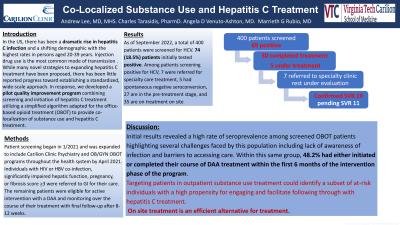Back


Poster Session E - Tuesday Afternoon
Category: Liver
E0468 - Co-Localized Substance Use and Hepatitis C Treatment
Tuesday, October 25, 2022
3:00 PM – 5:00 PM ET
Location: Crown Ballroom

Has Audio

Marrieth G. Rubio, MD
Carilion Clinic
Roanoke, VA
Presenting Author(s)
Andrew Lee, MD1, Charles Tarasidis, PharmD2, Angela Venuto-Ashton, MD1, Marrieth G. Rubio, MD1
1Carilion Clinic, Roanoke, VA; 2Carilion Helath System, Christiansburg, VA
Introduction: In the United States, there has been a dramatic rise in hepatitis C infection rates over the past decade and a shifting demographic with the highest rates of acute infections in persons aged 20-39 years. Injection drug use is now the most common mode of hepatitis C transmission and has been identified as a primary driver of the increasing incidence of infection. While many novel strategies to expanding hepatitis C treatment have been proposed, there has been little reported progress toward establishing a standardized, wide-scale approach. In response, we developed a pilot quality improvement program combining the elements of screening and initiation of hepatitis C treatment utilizing a simplified algorithm adapted for the office-based opioid treatment (OBOT) setting to provide co-localization of substance use and hepatitis C treatment.
Methods: Patient screening began in January 2021 and was expanded to include Carilion Clinic Psychiatry and OB/GYN OBOT programs throughout the health system by April 2021. Individuals with HIV or HBV co-infection, significantly impaired hepatic function, pregnancy, or fibrosis score >3 were referred to GI for their care. The remaining patients were eligible for active intervention with a DAA and monitoring over the course of their treatment with final follow-up after 8-12 weeks.
Results: As of February 2022, a total of 416 patients were screened for HCV. 90 (21.6%) patients initially tested positive and 294 (70.7%) screened negative for HCV (with 32 pending results). Among patients screening positive for HCV, 7 were referred for specialty care treatment, 36 were in the pre-treatment stage, and 5 had spontaneous negative seroconversion. 27 (31.8%) were actively undergoing DAA treatment. 14 (16.5%) completed their course of treatment among which 6 had obtained confirmatory tests of cure (8 pending).
Discussion: Initial results revealed a high rate of seroprevalence among screened OBOT patients highlighting several challenges faced by this population including lack of awareness of infection and barriers to accessing care. Within this same group, 48.2% had either initiated or completed their course of DAA treatment within the first 6 months of the intervention phase of the program. Targeting patients in outpatient substance use treatment could identify a subset of at-risk individuals with a high propensity for engaging and following through with hepatitis C treatment.
Disclosures:
Andrew Lee, MD1, Charles Tarasidis, PharmD2, Angela Venuto-Ashton, MD1, Marrieth G. Rubio, MD1. E0468 - Co-Localized Substance Use and Hepatitis C Treatment, ACG 2022 Annual Scientific Meeting Abstracts. Charlotte, NC: American College of Gastroenterology.
1Carilion Clinic, Roanoke, VA; 2Carilion Helath System, Christiansburg, VA
Introduction: In the United States, there has been a dramatic rise in hepatitis C infection rates over the past decade and a shifting demographic with the highest rates of acute infections in persons aged 20-39 years. Injection drug use is now the most common mode of hepatitis C transmission and has been identified as a primary driver of the increasing incidence of infection. While many novel strategies to expanding hepatitis C treatment have been proposed, there has been little reported progress toward establishing a standardized, wide-scale approach. In response, we developed a pilot quality improvement program combining the elements of screening and initiation of hepatitis C treatment utilizing a simplified algorithm adapted for the office-based opioid treatment (OBOT) setting to provide co-localization of substance use and hepatitis C treatment.
Methods: Patient screening began in January 2021 and was expanded to include Carilion Clinic Psychiatry and OB/GYN OBOT programs throughout the health system by April 2021. Individuals with HIV or HBV co-infection, significantly impaired hepatic function, pregnancy, or fibrosis score >3 were referred to GI for their care. The remaining patients were eligible for active intervention with a DAA and monitoring over the course of their treatment with final follow-up after 8-12 weeks.
Results: As of February 2022, a total of 416 patients were screened for HCV. 90 (21.6%) patients initially tested positive and 294 (70.7%) screened negative for HCV (with 32 pending results). Among patients screening positive for HCV, 7 were referred for specialty care treatment, 36 were in the pre-treatment stage, and 5 had spontaneous negative seroconversion. 27 (31.8%) were actively undergoing DAA treatment. 14 (16.5%) completed their course of treatment among which 6 had obtained confirmatory tests of cure (8 pending).
Discussion: Initial results revealed a high rate of seroprevalence among screened OBOT patients highlighting several challenges faced by this population including lack of awareness of infection and barriers to accessing care. Within this same group, 48.2% had either initiated or completed their course of DAA treatment within the first 6 months of the intervention phase of the program. Targeting patients in outpatient substance use treatment could identify a subset of at-risk individuals with a high propensity for engaging and following through with hepatitis C treatment.
Disclosures:
Andrew Lee indicated no relevant financial relationships.
Charles Tarasidis indicated no relevant financial relationships.
Angela Venuto-Ashton indicated no relevant financial relationships.
Marrieth Rubio: Gilead – Grant/Research Support.
Andrew Lee, MD1, Charles Tarasidis, PharmD2, Angela Venuto-Ashton, MD1, Marrieth G. Rubio, MD1. E0468 - Co-Localized Substance Use and Hepatitis C Treatment, ACG 2022 Annual Scientific Meeting Abstracts. Charlotte, NC: American College of Gastroenterology.
